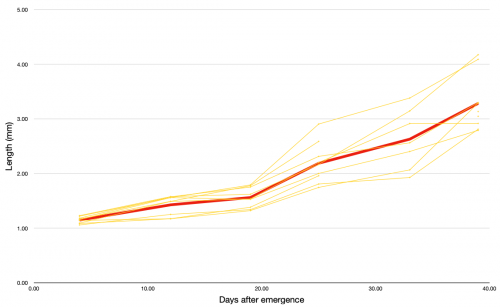I’m still regularly collecting data on growth rates in Steatoda triangulosa. Here’s what it looks like on day 39 (dark red line is the mean, I’ve included data for individual spiders in a lighter color to illustrate the variation):
They’re now at about, or over, half the adult body size, and are looking fairly mature. The palps haven’t fully matured, so I can’t sex them very well, but the ones I suspect are male — they just have a bit of a bulge — are on the smaller size. The couple that have really taken off look very female to me so far.
I’m discovering all kinds of complications, though. In particular, size is definitely a function of feeding. I gave them all a mealworm earlier this week, and some of them look hugely rotund right now. Fruit flies are definitely not adequate for the full nutrition of a growing spider, so it looks like I’m going to need to spruce up the mealworm colony soon. I’ve got another S. triangulosa egg sac that has reached the stage of seething darkness, which means I’ll have more babies this week.
Also the pigmentation is distinct and strong, and now it’s obvious that these spiders have white triangles on a dark background, rather than dark stripes on a pale background. This next batch of babies are going to require daily mapping of pigment patterns so I can see exactly what’s going on. I’m about to post a few photos on the Patreon page, if you want to see.



OT
Bad news
Olivia Newton John dead of breast cancer.
You know, we have this thing called The Infinite Thread specifically for any random off topic thing you want to say.
It’s interesting that some of the individual growth lines cross, meaning that initial weight is not the only determinant of growth weight. That’s to say the variation you see is not determined by just the initial variation.
Do you think sex has a baring on growth rate?
Oh I see you do answer that question. Some COVID brain here right now. Excuse me.
I think the biggest variable is feeding. I give them about the same amount to eat, but they’re finicky: unless the fly is snared in the web, they’re reluctant to chase after it (OK, they’re lazy).
They probably prefer ambush predator to lazy :P
Can you really measure spiders to 1/100th of a mm?
chris61, just saying, perhaps those are plotted lines over observed points.
(I sure can see where those data points might be)
But sure, no error bars on the featured graph.
(Though the axes are meaningfully labelled)
Thank you for providing a link to the infinite thread.
.
Data points? I can use half* that number of data points to prove Biden used the Internet to hack the voting machines!
.
As the spiders keep growing, you may eventually have to feed them medium-sized mammals. I wonder where I can find such …
(looks at image of Alex Jones on TV).
*the other half proves the climate is getting colder.
Sad spider tale
https://www.smbc-comics.com/comic/spider
I measure pixels on enlarged digital photographs; at the scale I measure at, there are 880 pixels/mm.
So on the one hand, yes.
On the other hand, there is significant variation due to the variable angle of the spider on the z axis, so no.
You measure what you can and report your measurements honestly and accurately. What else can one do?
“Report your measurements honestly”
I have located the flaw that prevents you from getting an article in “Science”.
Have you considered cold fusion research?
@12
Thanks, I was curious how one would do that with something you presumably don’t put under a microscope to measure.